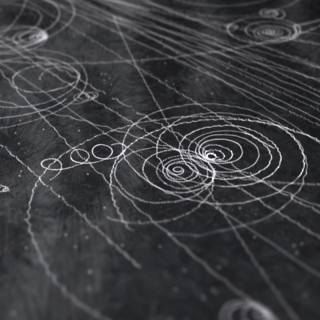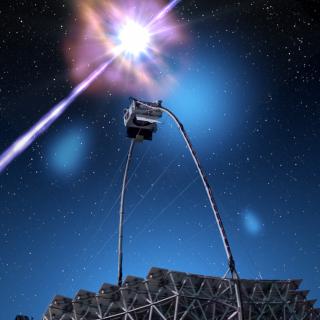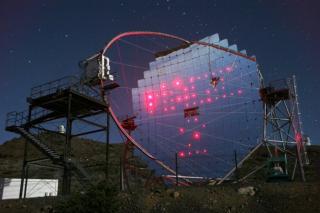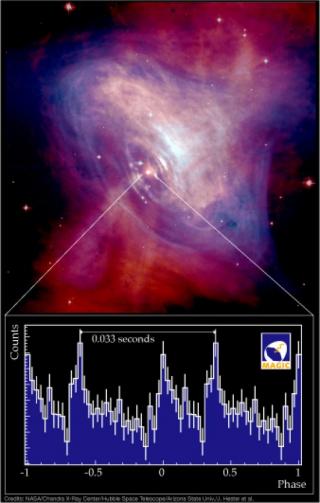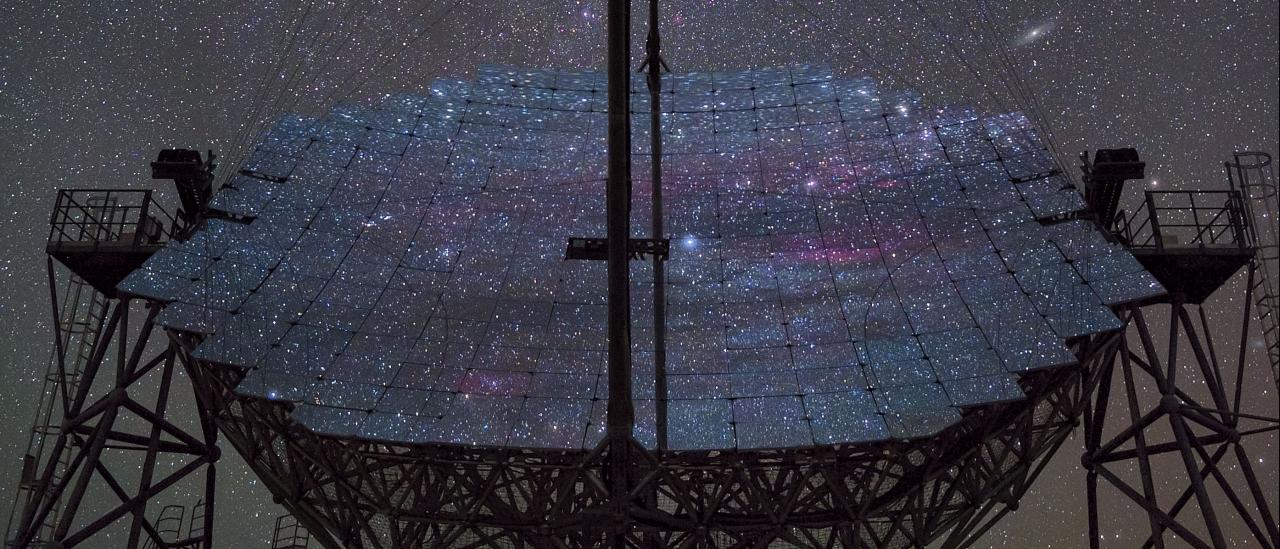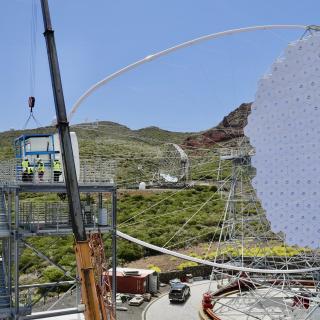El sistema de telescopios MAGIC observando la erupción de la nova RS Ophiuchi la noche de la detección de rayos gamma de muy alta energía (9 de agosto de 2021).
Scientists from the MAGIC collaboration, using a system of two 17m diameter imaging air Cherenkov telescopes located on the Canary Island of La Palma, Spain, have detected very high energy gamma-rays from a recurrent nova in the Milky Way. This event is the first one that has been detected at such energies and may provide new insight into this class of eruptions, and the potential role they play for producing the mysterious highly energetic cosmic rays that permeate the Milky Way.
The researchers present the results of their observations and insights they gained into this type of stellar explosions in an article in the journal Nature Astronomy on 14th of April 2022.
The life cycles of stars can be long and complex, from their birth inside dense clouds of cosmic gas until their often fiery end. How such a stellar death plays out depends on the mass of the star: for our own Sun, scientists expect that the nuclear fusion of hydrogen to helium in its core will end within the next 5 billion years. The Sun will then greatly expand to become a so-called red giant star, before collapsing back to a dense stellar corpse, a white dwarf. Such an end is typical for stars with masses roughly similar to the Sun. The material that makes up a white dwarf is very dense: a teaspoon full of it would weigh about a metric ton. Under some circumstances these dense stellar corpses can produce titanic explosions from beyond the grave. If the white dwarf has a stellar companion which itself progresses to the red giant phase, hydrogen from the extended outer layers of the giant can succumb to the fatal gravitational attraction of the dense dwarf, and accumulate on its surface. In some such systems, the pressure and temperature inside the accumulated layers reach a point where nuclear fusion reactions begin. Such a situation, a transfer of fresh material from a star still in the active stage of its life to a stellar corpse, can easily be reminiscent of legends about vampires sucking the life juice out of their victims, in this instance it is really a case of vampirism gone bad: The resulting nuclear explosion on the surface of the white dwarf ejects much of the hydrogen and fusion products into space. The explosion is very luminous, in many cases a factor of 100 000 brighter than the luminosity of a normal star like our Sun. Such a rapid increase in brightness of an otherwise unremarkable stellar system often led the astronomers of old to believe a new star had appeared – thus the term “stella nova” (new star, and in short “nova”) became a synonym for this process.
While the material ejected from the surface of the white dwarf escapes at a tremendous speed of two to four thousand kilometers per second, for the uneven stellar companions the cycle of gas transfer from dilute giant to dense dwarf can begin anew, and a future recurrence of the nova eruption will happen in some systems. Those then are called recurrent novae. For one well known recurrent nova in our Milky Way, the object RS Ophiuchi in the constellation Ophiuchus (the serpent-bearer) the typical time between two eruptions is about 15 years. With the last blast from the system having been seen in the year 2006, astronomers at the beginning of the third decade of the second millennium already knew that this celestial hydrogen bomb was primed and ready. They kept a watchful eye on the object at a distance of about 8000 light years from Earth. On August 8, 2021, light of the explosion reached the Earth and was promptly detected by ground-based optical telescopes and the Large Area Telescope on the orbiting gamma-ray observatory Fermi, operated by NASA. A suite of other observations followed, making this the first nova being detected over such a wide energy range from both ground and space. On August 9, astronomers from the MAGIC collaboration trained the twin 17m imaging air Cherenkov telescopes the collaboration operates on the Canary Island of La Palma at the ongoing eruption.
Says Ruben Lopez Coto (INFN Padova), MAGIC Galactic convener and one of the corresponding authors: “The eruption of RS Ophiuchi is a rare event in the gamma-ray sky: it is the most luminous nova and the one with the highest flux detected in gamma rays so far, and we just caught it on time.”
Owing to the good observation conditions on La Palma, the fast reaction of the collaboration, and the unique sensitivity of the MAGIC system, the nova could be clearly detected at energies hundred billion times more energetic than visible light.
Alicia López Oramas (IAC Tenerife), principal investigator for the MAGIC RS Ophiuchi observations, describes the new window to the sky that was thus opened: “This research has identified novae as a new type of source of very high energy gamma rays. This discovery has thus opened a new line of research in very high energy astronomy.”
Together with data from other wavelength regimes, the researchers were able to unravel a fascinating scientific story. The nova explosion was energetic enough to produce strong shock waves in the thin medium surrounding the stellar system. It is these shocks that are a prime mechanism in nature for accelerating tiny subatomic particles to nearly the speed of the light. In the case of the nova RS Ophiuchi 2021, the model best describing the observations of MAGIC and other telescopes traces the very high energy gamma-rays detected by MAGIC back to the acceleration of protons, positively charged particles that are the nuclei of hydrogen atoms. Although nova eruptions are individually less energetic than their much more violent cousins – supernovae, where a star perishes in a catastrophic explosion – they are also much more frequent. The results obtained by the researchers of the MAGIC collaboration and colleagues indicate that although the bulk of the highly energetic cosmic rays permeating the Milky Way probably stem from other sources, novae seem to be surprisingly efficient in carving out local regions of cosmic ray overdensity in their galactic neighborhoods.
David Green (MPP Munich), MAGIC Galactic convener and one of the corresponding authors, describes the breakthrough achieved now: “The spectacular eruption of the RS Ophiuchi shows that MAGIC’s fast response and patience really pays off. This result shows that novae shine bright in very high energy gamma rays originating from proton acceleration and open a new window into the very high energy gamma-ray sky.”
To fully understand the complicated interplay of violent events with the interstellar medium in the Milky Way, more observations like those reported now will be necessary. The MAGIC collaboration will continue the celestial watch for the unrest of dense stellar remnants in the Galaxy and beyond.
Julian Sitarek (University of Lodz), corresponding author of the publication: “While the modeling of the gamma-ray emission from RS Oph provided us the first convincing evidence of proton acceleration in novae, it is still unknown if the emission is related to peculiarity of having the Red Giant as the companion star, or rather a more general property of all novae. Further observations of novae with Cherenkov telescopes will allow us to answer this question.”
Concludes Oscar Blanch (IFAE Barcelona), spokesperson of the MAGIC collaboration: “Within MAGIC, we have been following up on nova explosions for quite some time already. It is always very gratifying when you see that the efforts pay off and we manage to open new windows that bring deeper knowledge of our universe. It is the effort of many people.”
Article: Acciari, V.A., Ansoldi, S., Antonelli, L.A. et al. "Proton acceleration in thermonuclear nova explosions revealed by gamma rays". Nature Astronomy (2022). DOI: https://doi.org/10.1038/s41550-022-01640-z
Contact at the IAC:
Alicia López Oramas, alicia.lopez [at] iac.es (alicia[dot]lopez[at]iac[dot]es)
